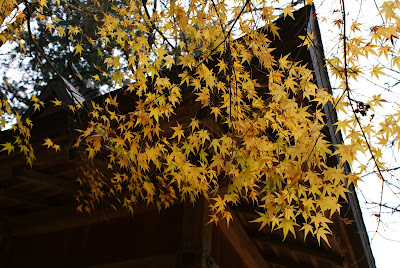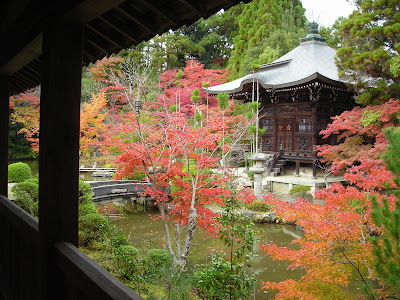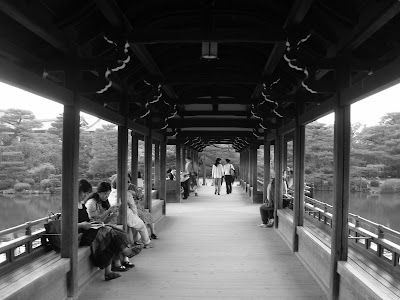What I did during my vacation
Eve of All Hallows, 2009
I queued. I didn’t really mean to. When I packed to leave Kyoto for Singapore, I didn’t plan to do much more than catch up with people and books I hadn’t seen in months.
But avoiding crowds was high on my list of things to do. So was staying out of any kind of queue because there are only so many people you can go on holiday with.
Then it was announced that Neil Gaiman would be appearing at the Singapore Writers Festival at the end of October.
Are introductions in order? Neil Gaiman: author of The Sandman, a fantasy series that has become so much of a hit that the comic books are now called graphic novels, and writer of short stories, novels, poems, film scripts and children’s books. Of these, The Graveyard Book has spent over a year on the children’s best-seller list of the New York Times though everyone I know who loves the work is old enough to drive.
It’s a reimagining of The Jungle Book; instead of a boy being brought up in a jungle by animals, he’s brought up in a cemetery by dead people. And a vampire.
The novel may well turn out to be one of those books you keep returning to and measuring yourself against, like standing beside a mark scratched on a wall to show how tall you were at nine because you want to see how much you’ve grown.
So great that the author would be coming to town, yes? There was only one snag: all the tickets for his three events were gone on the first day of distribution, even though it was announced only via Twitter.
To accommodate the demand from everyone not on the Twitter feed, the festival staff increased the venue capacity and announced that they would release a ‘VERY VERY LIMITED number of tickets’ on Sept 26.
When I read this on the festival website, I began to see visions of queues. There’s one thing I haven’t mentioned about Mr Gaiman. Yes, he’s versatile, yes, he’s prolific and yes, he wins all those awards but what he really is, is a queue-maker (like a rain dancer but more horizontal).
The mere hint of his presence is enough to draw previously unconnected people out of the great mass of humanity and assemble them into a line. This happens all over the world – at literary festivals, bookstores and conventions – and I knew it would happen on Sept 26 at The Arts House because of the promise of tickets to see He Who Brings Queues.
The question was, how early would I have to turn up before the distribution time of 11am if I wanted to be sure of a pair of those VERY VERY LIMITED tickets?
It didn’t help that I work late and go to bed even later. But after crashing out for five hours and hitting the alarm clock’s snooze button for half an hour more, I stumbled into the kitchen at 7.30am.
My mother was there. ‘You mean you haven’t gone to bed yet?’ she said.
Then again, she might not have been my mother. Since I’m technically not awake between the hours of 6am and 9am, anyone I see then must be a figment of my imagination.
The taxi-driver looked pretty real though. I asked him to take me to Parliament House – near The Arts House but not in the area closed off for the F1 races that weekend. He frowned. I held my breath: was he going to refuse to go anywhere near the barricades?
It turned out that he just didn’t know where Parliament was.
But between the both of us, we got there. It was almost 9.30am – one and a half hours before the box office’s opening time – when I made my way past the F1 barricades and security personnel to The Arts House.
Two girls in short shorts were approaching from the venue. ‘…queuing since 6.40!’ said one of them as she went past.
I stopped. What if the line had reached such epic proportions that those two had given up and were on their way home?
I kept on walking. Even if I didn’t get the tickets, there might be a story in it. To be a writer is to slink up to life with a scavenger’s optimism.
The queue began at the locked front door and snaked out of the portico. Since each person was eligible for two tickets, the line was actually twice as long as it appeared. Was I too late?
I left my bag at the end of the queue to stake a spot in that fine Singaporean tradition of chopeing and went to talk to the people up ahead. The first person in the line said she’d been there since 6.40am. She beamed at me, her smile and light green tudung unwilted despite the heat. No. 2 clocked in ‘just past 7’ and No.3 and No.4, at around 7.30am.
Humbled, I went back to do some proper queuing. I’d brought two books but a conversation was starting up in my neck of the queue, mainly about the tickets. One woman confessed that she was hoping that the F1 road closures would deter fans from coming. I had the same thought; devious minds think alike.
To pass the time, we reminisced about other occasions when Singaporeans had gotten into line and stayed there for hours. But the girl behind me was from the Philippines and knew nothing about the Great Hello Kitty Scuffles of 2000.
In the January of that year, McDonald’s launched a promotion offering customers Hello Kitty toys with each Extra Value Meal they bought. Lines sprang up, tempers grew short, fights broke out and people were arrested. At one outlet, a glass door broke against the press of the crowd, injuring seven.
You can think of a queue as a social microcosm. In one line, you’re told what a society values, how much it wants it, how much trust there is in the system to provide it and whether people will resist the urge to jump the queue.
Almost 10 years on from the Hello Kitty Scuffles, how was Singapore doing? The line outside The Arts House that Saturday morning presented the country as orderly and international.
But the nature of the queue might have had something to do with the fact that it was there for Neil Gaiman. For a start, more people were reading than fiddling with their phones.

Still, there was no guarantee of what would happen if there weren’t enough tickets to go round. Some of the books people were holding looked pretty heavy. If the situation turned Hello Kitty, things could get ugly.
For now though, everything was calm. A trio went past, wheeling a trolley of equipment – probably for an F1 event. They seemed surprised to see so many people sitting in a line on the ground and reading.
10.05am – an hour to go and the sun was weighing down. Anybody want to share life stories?
So I talked to the five people around me in the queue. There was Kim, a student from the Philippines, Xuemei, a civil servant, Eldred, who draws, Wanida, who works for Apple and had come with a laptop, and Pat, who handles administration at a polytechnic, has five children aged three to 14, takes all of them on holiday, teaches women to give birth and is on the fast track to a medal.
She said that if she got a pair of tickets, one would go to her 13-year-old son, also a fan.
‘And where is he?’ I asked.
‘At home,’ she said and laughed. ‘Sleeping.’
There was a collective intake of breath as we considered the likelihood of our mothers queuing up for Neil Gaiman tickets for us while we stayed in bed.
‘I don’t think my mother even knows who Neil Gaiman is,’ said one woman who will remain anonymous in case her parents read this.
On his blog, he describes himself as the ‘guy you’ve never heard of’ who ‘gets more people in his book-signing line than anyone else’. This line has been known to stretch to about 600 people.
Our queue was nothing along those lines but everyone in it was competing for a fixed number of tickets. The conversation flowed, snagging at times on the uneasiness underneath.
Two people ahead in the line stood up and shook out their groundsheet. ‘Do you think they’re giving up?’ someone asked hopefully.
‘They came with a mat – they’re not going to give up,’ someone else growled.
Sure enough, the two rearranged their sheet and sat down again.
I looked away to see an old man staring at us. A cap of flashing pink sequins on his head, he shuffled past, a smile crinkling his face. ‘Ni men hao!’ he bellowed. Hello to you too. Perhaps it takes a lunatic to acknowledge a whole line of them.
People were still arriving. They would do a double-take at the queue which now stretched along the front of the building and onto the grass at the other side. Then they would go to the end, their shoulders slumped.
11am – my queue buddies and I stood up. We paused only to get each other’s contact details then faced forward as if we could see through the bodies to the number of tickets left. Were people still talking? I don’t know; I couldn’t hear them any more.
And then I finally reached the table where the festival staff were handing out tickets from three dwindling stacks.
Maybe I was sunstroked out but I couldn’t quite believe it, not even when two tickets were in my (newly tanned) hand. The five who queued with me had their tickets too and all of us had picked the same event. ‘Let’s meet for lunch or something before that,’ said Kim.
Outside the portico, a burly, long-haired man in black was taking a photo of his tickets.
But not everyone was happy – about 20 people had to go away empty-handed. Amid the cries of disappointment, one young girl looked stricken. A few people exchanged words with the festival staff but as far as I could tell, they were polite. Perhaps we’d come out from under the shadow of Hello Kitty.
I couldn’t leave without seeing how it all ended because the conditions that give rise to a queue are also those that create a community: people with the same purpose come together, demanding attention through presence. But there is also envy of those ahead and a gnawing anxiety that you won’t get what they will. The factors are always the same yet the manner in which similar desires are balanced against competing interests is different each time.
So I stayed because I wanted to see what kind of queue, what kind of community we’d made. And when I left at last, I took more than tickets away with me.
When I got home, I headed straight for the shower, relieved that for this at least, I didn’t have to line up.
Because you know what I said about queues and community-building and all that stuff? When it comes to the bathroom, none of it applies.




















































